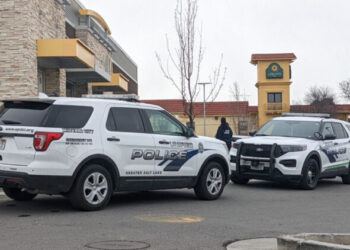On Tuesday evening, hundreds of people took to the streets of Minneapolis to protest police violence in the wake of the death of George Floyd, a Black man who died after a white police officer knelt on his neck.
The view of the protest from the top of a building next door. @mprnews pic.twitter.com/prBI5cJl1g
— Evan Frost (@efrostee) May 26, 2020
Floyd was being held face-down by a Minneapolis police officer, who kept his knee on Floyd’s neck as he pleaded, “I can’t breathe.”
Demonstrators gather near the spot where a bystander’s now-viral video captured Floyd on Monday — most wearing masks, following requests from organizers based on guidance to prevent the spread of coronavirus — then marched toward a police precinct. They held signs with the rallying cries “No justice, no peace,” “Black lives matter” and “Stop lynching us.”
You could say there’s a bit of a crowd gathering in Minneapolis. #GeorgeFloyd pic.twitter.com/03d06yQxYm
— Omar Jimenez (@OmarJimenez) May 26, 2020
Police later arrived in riot gear at the scene of the protest outside the local precinct and appeared to use tear gas to disperse demonstrators, according to local reporters and photographers. Minneapolis police did not immediately respond to a request for comment.
Four Minneapolis police officers were fired on Tuesday after Floyd’s death. The FBI and Minnesota’s Bureau of Criminal Apprehension are investigating the incident.
(Video taken at 4:30pm but wouldn't send due to service issues)
— Jeff Wagner (@Jeff_Wagner4) May 26, 2020
Crowd at the protest for George Floyd extends well down each block as people try to be socially distant. @WCCO pic.twitter.com/ptgHEX4bGm
So much tear gas. pic.twitter.com/mEW2lwqB7c
— Evan Frost (@efrostee) May 27, 2020
Organizers of Tuesday’s protest are demanding “justice for the victim and his family,” including the release of the officers’ names and criminal charges against the four.
More signs from today's protest and march at 38th and Chicago Ave in Minneapolis. pic.twitter.com/3y1ynE6vRX
— bengarvin (@bengarvin) May 26, 2020
Floyd was unarmed and handcuffed on the ground when the officer knelt on his neck. Floyd eventually closed his eyes and stopped speaking. Police called for an ambulance, but Floyd died shortly after arriving at a hospital, the Minneapolis Police Department said.
We are out covering protests—Callen Gray and I almost hit by chemical agents—protestors are not budging outside 3rd precinct @kstp pic.twitter.com/X8gBn1UnDC
— Eric Chaloux (@EricChalouxKSTP) May 27, 2020
Floyd’s death follows in a long line of killings of unarmed Black people at the hands of law enforcement, his case echoing that of Eric Garner in New York, who was also unarmed and died in 2014 after pleading “I can’t breathe” as a cop held him in a chokehold.
The scene at the Minneapolis 3rd Police Precinct. pic.twitter.com/ykxsfPn8PD
— Carlos Gonzalez (@CarlosGphoto) May 27, 2020







